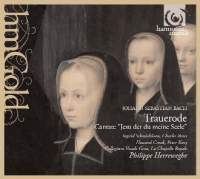Texte paru dans: / Appeared in: |
|
|
Outil de traduction (Très approximatif) |
|
|
Reviewer: Nicholas Anderson My first encounter with Bach's poignant and deeply felt funeral music for Christiane Eberhardine , Queen of Poland and Electoral Princess of Saxony, was through a recording by Hermann Scherchen. Some years later followed a fine account of the same cantata (No. 198) by Nikolaus Harnoncourt (Teldec/ASV) but less effective ones by Michel Corboz (Erato) and Helmuth Rill ing (Hiinssler-Verlag). Now Philippe Herreweghe enters the lists and places himself, along with an appealing group of soloists, comfortably among the gods. The work dates from 1727 but Bach returned to the music on two later occasions , incorporating the framing choruses in his funeral music for Prince Leopold of Anhalt-Kothen (BWV244a), and these as well as the arias in his SI Mark Passion (BWV247).
Christiane Eberhardine was a fervent believer in the Reformed religion of Protestant Saxony and we may well imagine that Bach would have been eager to turn in his finest work for one who had displayed such firmly rooted convictions. That he did so is beyond question, for the cantata is a masterpiece of elegiac inspiration, a tender, intimate and seemly personal tribute to a much loved monarch. These are qualities highlighted by the delicately transparent scoring: flutes, oboes, oboes d'amore, violins, viola, viole da gamba, lutes and continuo. With these subdued colours, and with a beautifully constructed pattern of movements whose framework consists of three B minor choruses, Bach suffuses the music with an especially affecting blend of melancholy and joy. Herreweghe skilfully captures the subtle mood of the piece with a lively feeling for detail in which he is strongly supported both by his solo vocalists and by the choir of La Chapelle Royale. The two outer choruses are brisk-so they should be for they are dances in all but name-yet keeping that delicate balance between earthly sorrow and spiritual ecstasy. I'm not sure that it was such a good idea to introduce a bassoon to the continuo line but it certainly had unwarranted prominence in the pictorially vivid recita tive "Der glocken bebendes Geton ". Here, too, I felt that Charles Brett might have given more emphasis to Gottsched's colourful text. His aria, on the other hand, is very well sustained with a fine understanding of its lyrical content.
The other cantata on the disc is no less a masterpiece. Jesu, der du m eine Seele belongs to the second Leipzig cycle and is one of the most powerful examples of Bach 's skill in composing choralecantatas. Its textual basis is a hymn by the seventeenth-century writer Johann Rist , two verses of which are incorporated as they stand . The opening chorus is a grief-laden chaconne, a profound lament: " Jesus, who by your bitler death have torn my soul from Satan'sdark cavern . . . be now, o God, my refuge!". Following it comes a duet which takes us closer to Italian opera, perhaps, than any other vocal music from Bach's pen . The soloists, Ingrid Schmithiisen and Charles Brett are well matched and give a radiant performance with deliciously light-footed support from the cello continuo. It 's an enchanting movement which is likely to loosen the rusty hinges of doors stubbornly closed to the music of Bach's church cantatas. The tenor aria is a fine one, too ; it's scored for flute and continuo and is sung with understanding and considerable technical finesse by Howard Crook. Peter Kooy gives an expressive account of his lovely accompanied recitative and is effectively balanced with the florid oboe obbligato in the subsequent aria .
.... |
|
|
|
|
|
Cliquez l'un ou l'autre
bouton pour découvrir bien d'autres critiques de CD |
|



